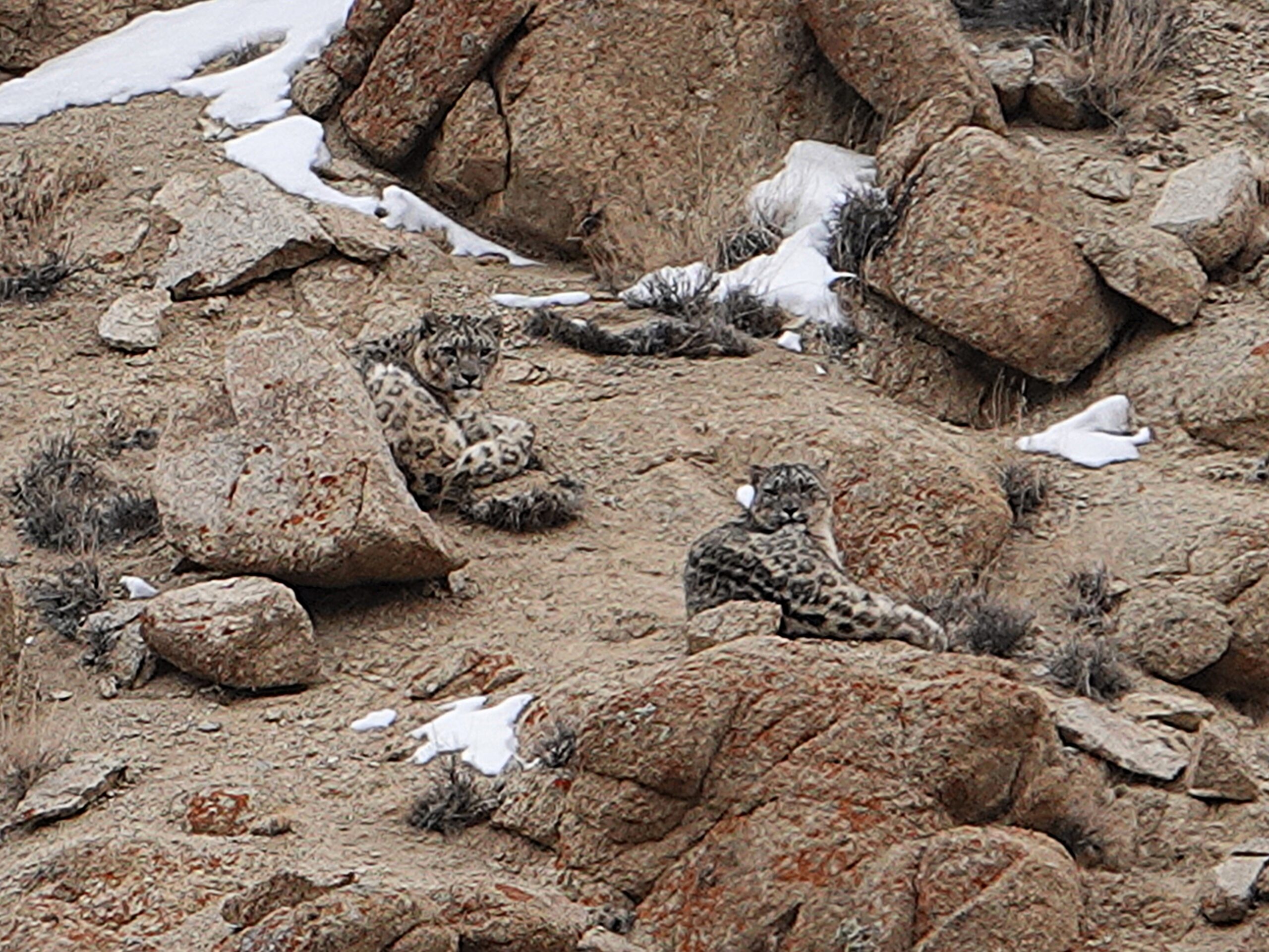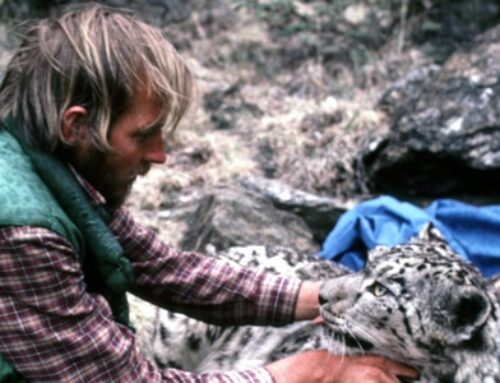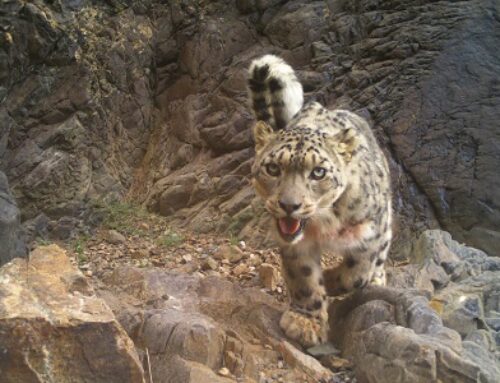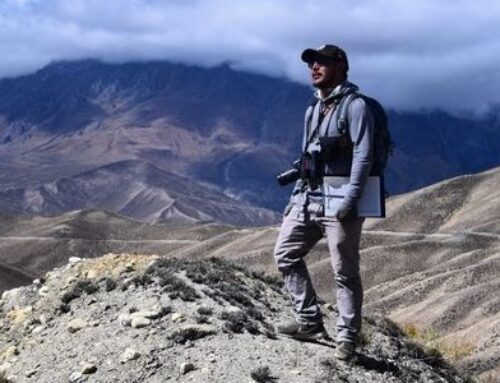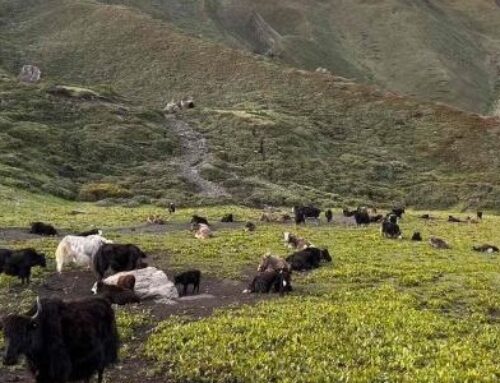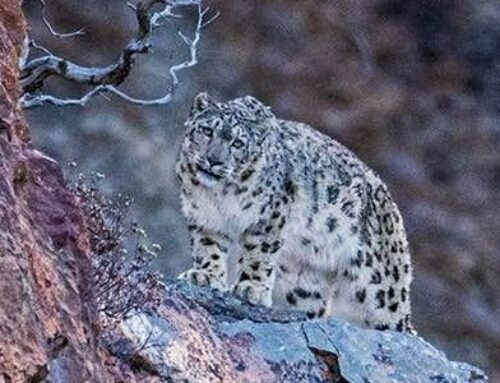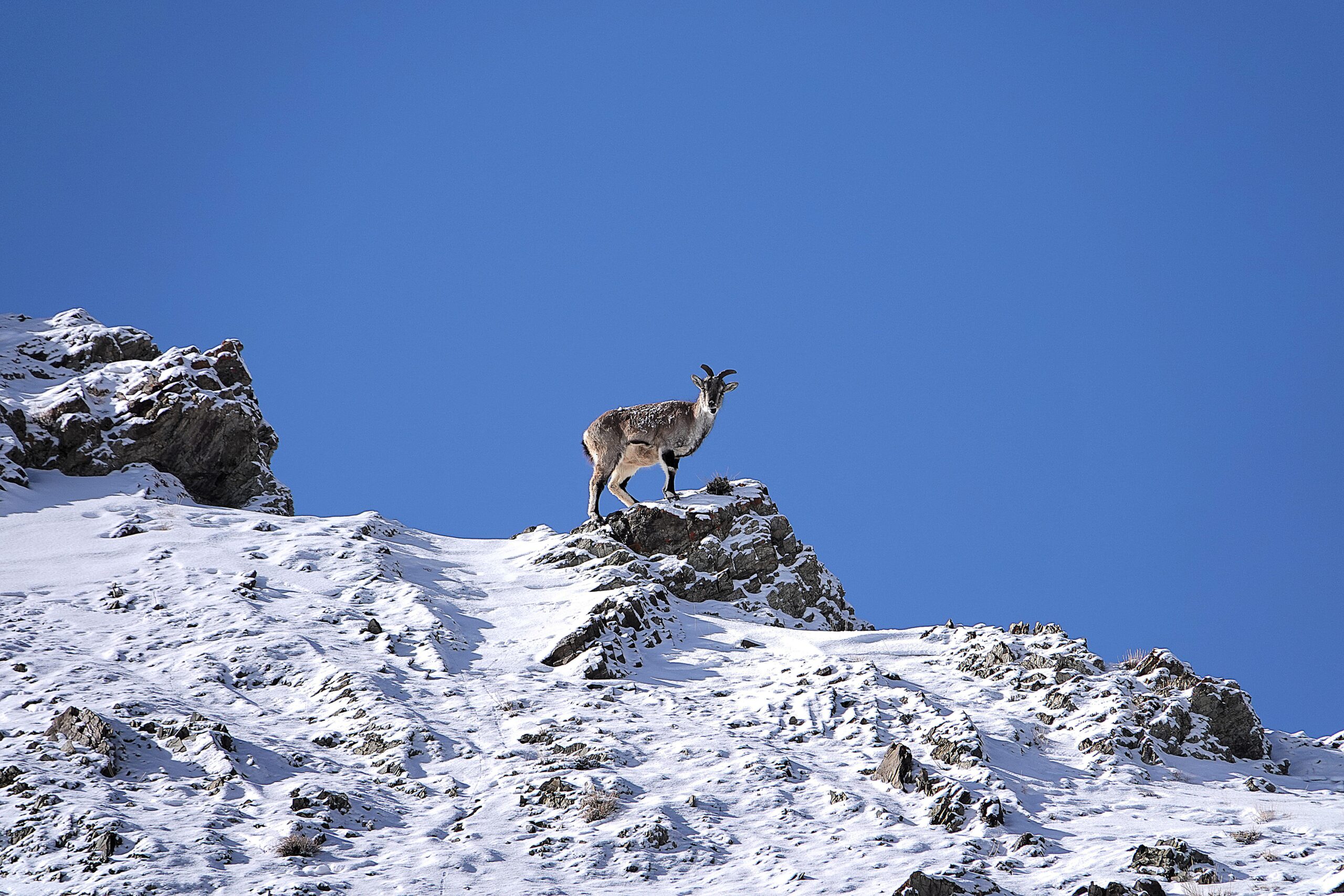
Blue sheep – the main prey species for snow leopards
Photo by John Stanis
NOTES FROM THE FIELD
LADAKH UNION TERRITORY, INDIA
by Charleen Gavette
As I lay inside the cozy cocoon of my double thick sleeping bag, the early morning light gently seeping through the tent walls, I couldn’t help but contemplate the herculean effort it would take to extricate myself from its warmth. The frigid air outside seemed like a formidable adversary, threatening to freeze me as I assembled layer upon layer of clothing.
But just when I was locked in this internal battle with my own inertia, a shout pierced through the quiet of the morning: “Shan! Shan! Shan! Quickly! Quickly!” It was as if a bolt of lightning had struck me. In an instant, I sprang out of my sleeping bag, clumsily donned clothes, jacket, and boots, and stumbled out of the tent, impervious to the biting cold. A snow leopard had been spotted, and not just spotted, but it was right near our camp!
The dedicated guides had been tirelessly scouting for signs of these elusive creatures as soon as the first rays of sunlight graced the horizon, and now, we were the lucky recipients of their relentless dedication. The camp crew pointed us in the direction, and we set off, our movements hindered by the high altitude and the multitude of clothing layers.
After a short walk, we found ourselves on a terraced area where two rivers converged. Across the ravine, framed against a breathtakingly brilliant blue sky, perched high on a ridgeline overlooking the chasm, was a solitary snow leopard. It chose not to grace us with its presence for long, but that didn’t matter. Even a fleeting glimpse of such a majestic creature was enough to disrupt any routine.
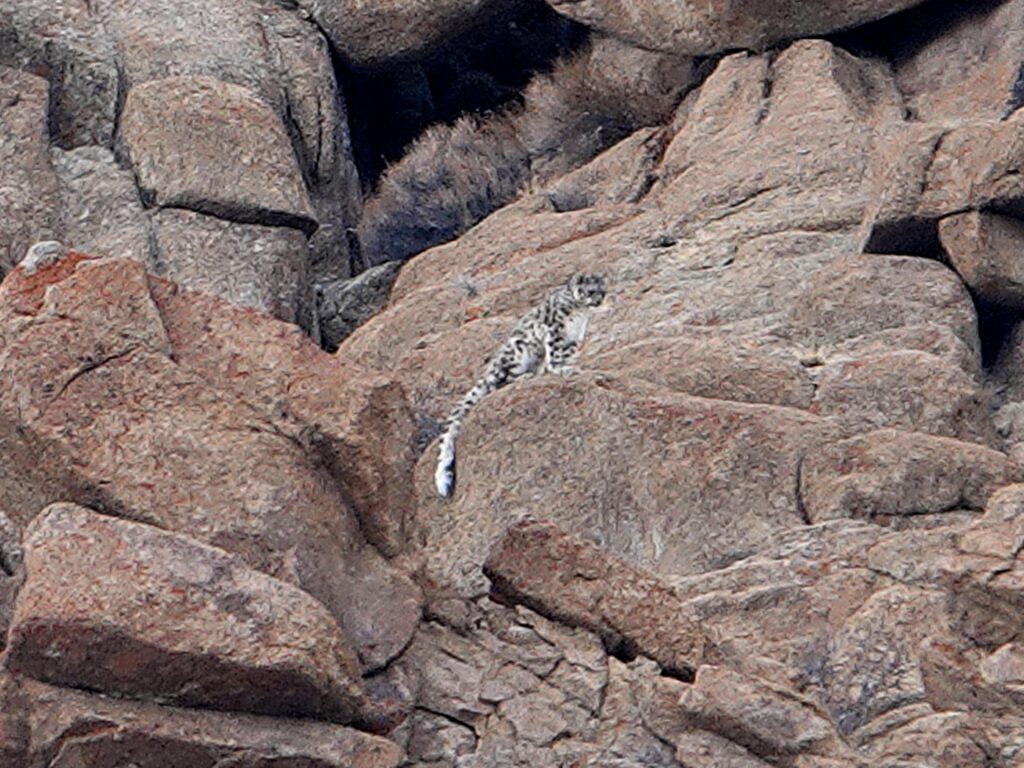
Solitary snow leopard
Photo by John Stanis
To witness the grandeur of a snow leopard in the wild is an experience that lingers, sending shivers down the spine even in recollection. When we embarked on this two-week trek, we hoped that we might be fortunate enough to spot one of these elusive cats. Little did we know that our luck would far exceed our wildest dreams. We were favored with encountering eight individuals spanning the spectrum of life stages, from a nurturing mother with two curious yearling cubs to solitary males and females; from a wise, weathered old-timer who had seen the world to a mating pair bringing new life into the world.
Simply being in the realm of these magnificent creatures felt like an unparalleled privilege. Our journey to the Ladakh Union Territory in India held multiple purposes. Ashleigh Lutz-Nelson, Snow Leopard Conservancy executive director, and I aimed to evaluate the guest experience of the citizen scientist participants on the trip provided by KarmaQuest, an ecotourism and adventure travel company supporting snow leopard conservation. Additionally, we sought to assess the local ecotourism operator, Overland Escapes, all while reconnecting with the Snow Leopard Conservancy-India Trust (SLC-IT). This trip was a chance to meet the staff of SLC-IT, a non-profit organization founded by Dr. Rodney Jackson and Mr. Rinchen Wangchuk, and to delve into ongoing projects, including the Rumbak homestay program within Hemis National Park.
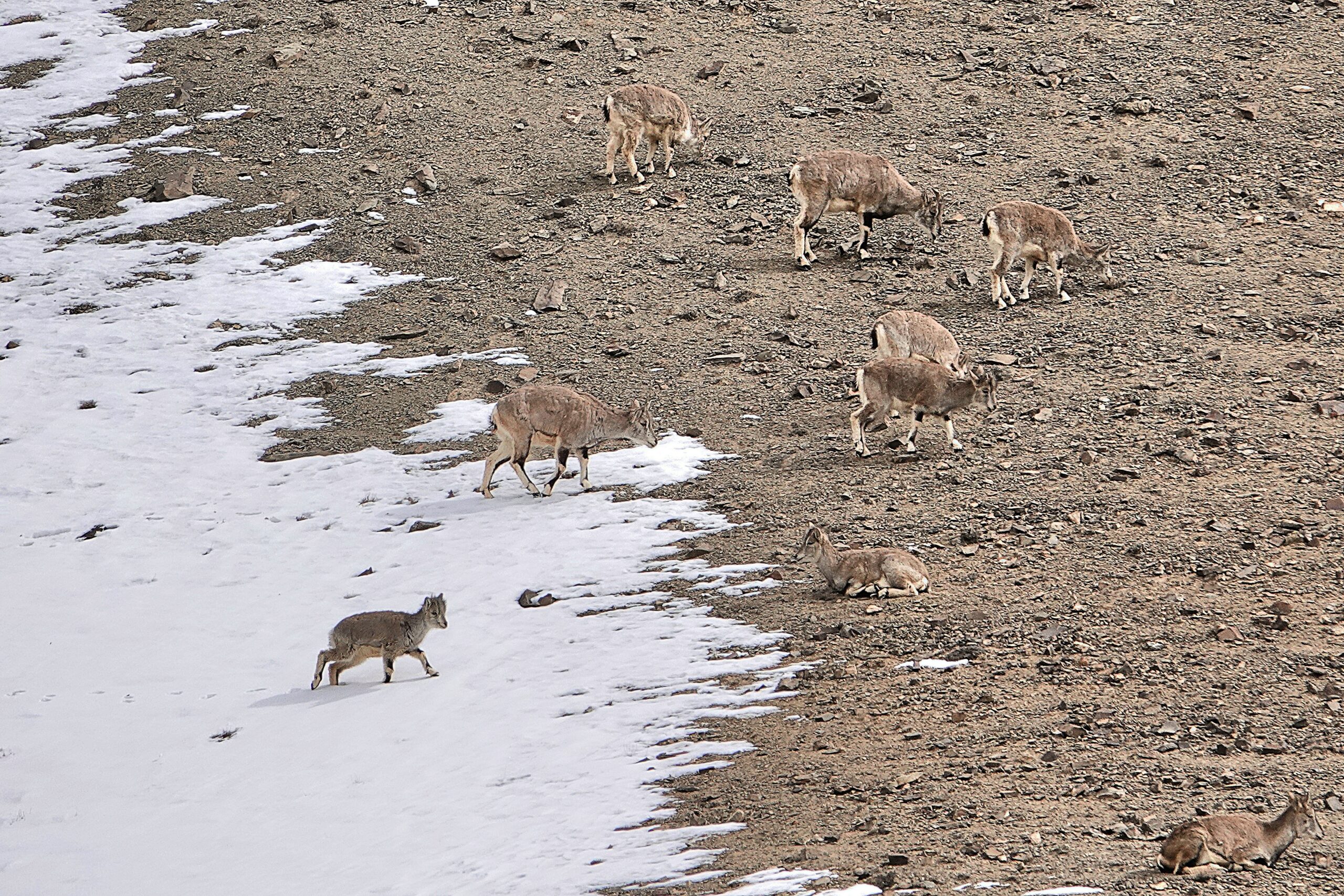
Flock of blue sheep
Photo by John Stanis
Our journey also provided a unique opportunity to forge new collaborations within the conservation sector in snow leopard habitats. We looked forward to visiting the Leh wildlife rescue center and sanctuary as well as engaging with other conservation nonprofits.
Yet, the ultimate reward of our reconnaissance was the opportunity to witness these wild snow leopards in their natural habitat. The stark, intense beauty of the endless mountains took our breath away, and seeing a snow leopard roaming freely, untouched by human constraints, was the emphatic punctuation mark for the work we do. It reminded us why our efforts and those of the Snow Leopard Conservancy are so vital.
Our travels began with flights from San Francisco to Delhi and then on to Leh, Ladakh. We arrived a few days ahead of the KarmaQuest group, giving us time to meet with local organizations dedicated to high mountain conservation and set the stage for an adventure that would forever be etched in our hearts and memories.
The first thing we noticed once in Leh was the vast number of feral dogs, estimated at about 11,000 dogs in Leh district alone. In Ladakh, there are approximately 250,000 people and over one million feral dogs. These dogs pose a threat to both humans and wildlife, with packs that hunt and kill local wildlife and make it too dangerous for people to walk at night. The complex issue of managing their numbers in adherence to Buddhist beliefs, which prevent killing the dogs, is a pressing concern. To implement a successful sterilization and vaccination program to humanely control the population would require a gargantuan coordinated effort.
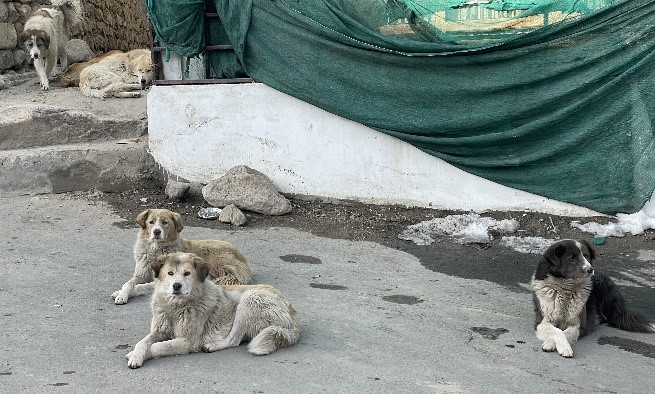
Feral dogs in Leh, Ladakh
Photo by Ashleigh Lutz-Nelson
Our meetings with the Snow Leopard Conservancy-India Trust staff in Leh were fruitful. We exchanged ideas on conservation programs, including an education project they are conducting involving local monasteries which could be replicated across snow leopard range and a strong field program which includes new research piloting new techniques for herders to minimize conflict with predators.
We also had the opportunity to visit the World Wildlife Fund office in Leh, recognizing the importance of coordination between different organizations working toward snow leopard protection and conservation at several levels.
Soon, it was time to embark on our snow leopard trek with KarmaQuest and Overland Escapes. The rest of our group had just arrived in Leh, but upon hearing a snow leopard was nearby, they chose to set their bags down, and we were off. Near the upper extent of a town nestled up against a mountainside, we found ourselves amidst a crowd. Quickly, though, our attention was drawn to a snow leopard perched about 50 meters up a slope, near its kill. This cat had been guarding its prey for two days, making it clear that it had no intention of sharing, rising only to chase magpies and dogs away. I was able to clearly see his heavily scarred face and dun colored coat, camouflaged so well with the rocks. He had chased an adult ibex over the ridge and caught it mid-way downslope. And there he sat and would continue to sit until all remains were eaten.
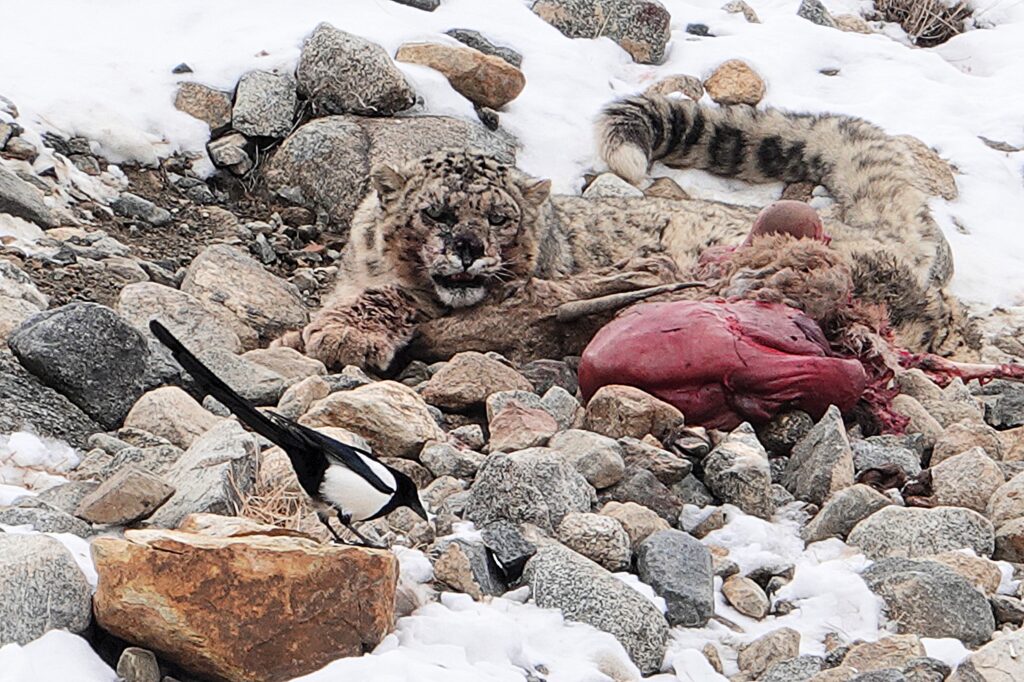
Elderly male snow leopard protecting his kill from a magpie
Photo by John Stanis
On our way back to the hotel, we made a stop at a government-run wildlife sanctuary, home to three snow leopards that were deemed unreleasable due to injuries as a result of conflict. The facility served both as a place for rehabilitation and release as well as a permanent sanctuary. We learned that the Indian government’s regulations mandated that snow leopards held in captivity for over 30 days could not be released back into the wild, presenting a challenge for those involved in their care. Any cat brought in for care must be released by day 30, or it will spend the remainder of its life in captivity. In fact, a rehabilitated cat was nearing the 30-day limit, and there was much urgency by the team to get it released before the deadline. Due to the high level of snow leopards coming into the facility as a result of conflict over livestock depredation or related injuries, there were plans to expand this government facility two-fold. In the meantime, zoos across India also receive snow leopards from the wild deemed unreleasable, which was another pressing concern.
Finally, we embarked on the actual trek, driving to Hemis National Park where our tents awaited us in the heart of a stark, snow-covered valley, surrounded by towering mountains and devoid of trees. It was a pristine, isolated landscape where nature reigned supreme.
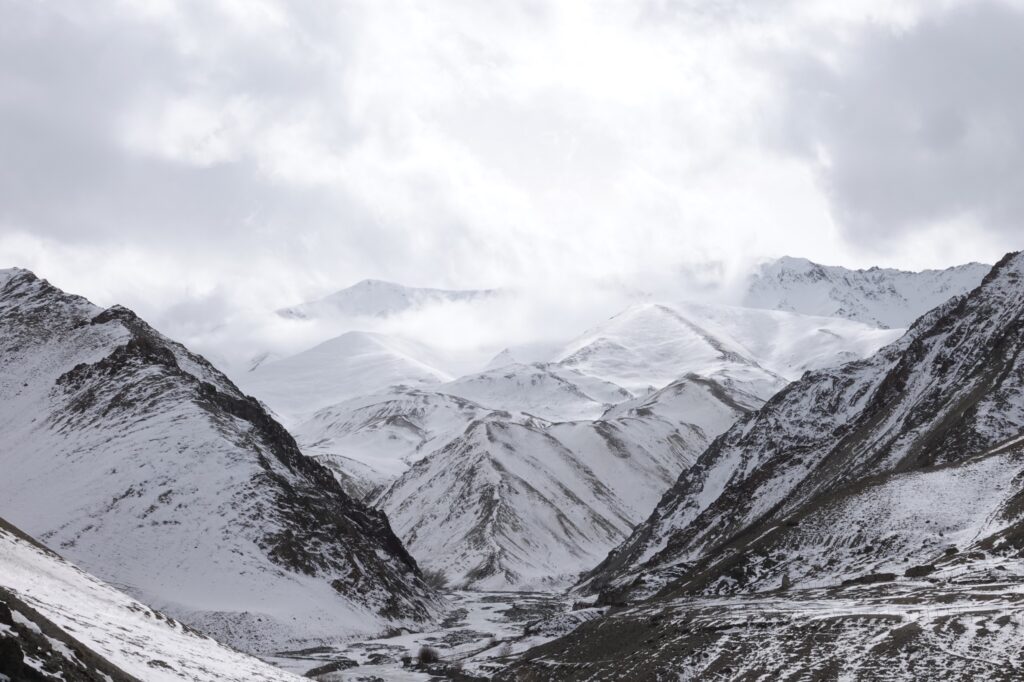
Trans-Himalayan Mountains
Photo by John Stanis
Over four nights in tents and three nights in a homestay in Rumbak village, our days began with hot tea and biscuits delivered to our tents, followed by hearty breakfasts and discussions with the guides about the day’s plans. Our activities were guided by the latest sightings and information from other local guides.
Our first full day led us on a hike up the river valley, with no immediate signs of snow leopards. Nonetheless, the stunning scenery and glimpses of smaller animals and ibex kept us engaged. Later in the day, we received news of a lone snow leopard across the park, and we hastily drove to the site, even though it required circumventing the park’s exterior to reach it. The cat, perched mid-slope on a steep mountainside, was a true master of camouflage, and without the expert guidance of our local guides and their spotting scopes, we would have missed it entirely.
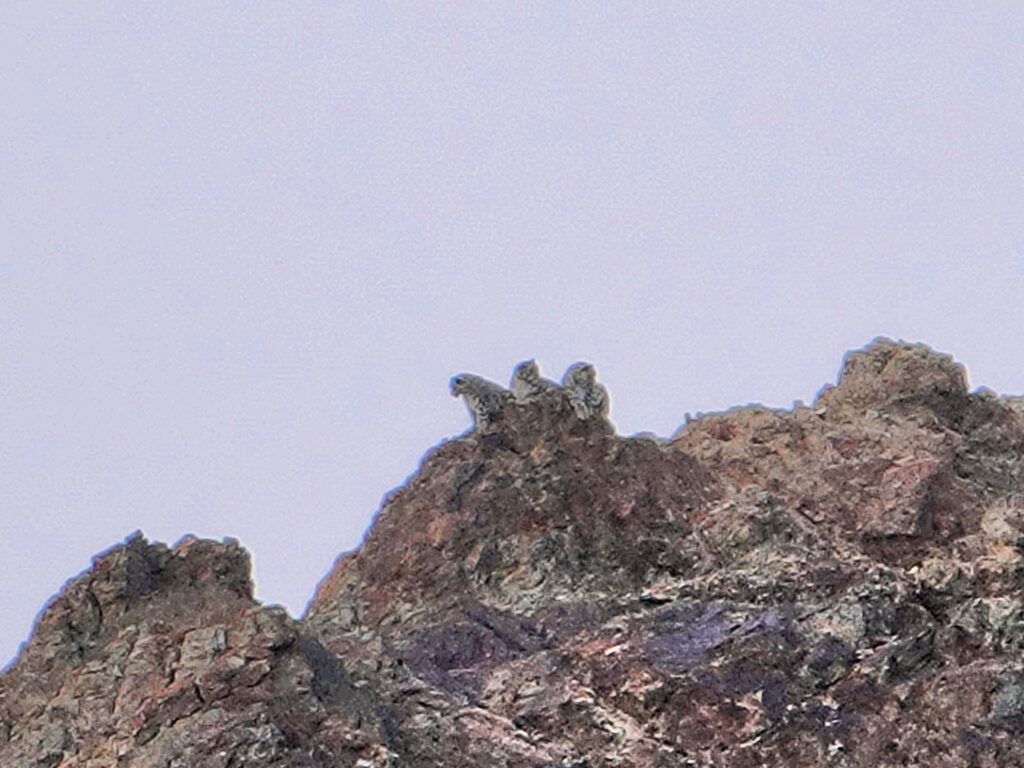
Mother snow leopard with her two yearling cubs
Photo by John Stanis
Our last day of camping was an absolute highlight as we encountered a female snow leopard with two yearling cubs near our campsite. It was a gloriously sunny day, with a brilliant blue sky, towering mountains all around, and three snow leopards on the slope across the river channel, absolutely idyllic. The spotting scopes were set, and binoculars were in hand; we were ready for the day. The playful cubs were hilariously tackling each other and stalking mama as she stalked a herd of blue sheep that was moving by unaware of the snow leopards’ presence. After a bit, mama stashed her cubs in a recessed cleft in the rocks and spent the day lazing in the sun, occasionally looking around to see if any dinner may be strolling by. While she slept, we were all rapt, simply witnessing the beauty of untamed nature.
By midafternoon, the cubs emerged ready to play. We watched as they followed mama across the slope up to the ridgeline. There, three faces peered over the rocks in our direction. They all looked so regal in one moment. In the next, the cubs showed they were still kids as they romped and jumped and rolled down the ridge, trailing after mom.
We continued on our journey with a homestay in the small enclave of Rumbak village, where we experienced warm hospitality despite language barriers. Many families have two or three yaks or dzo (yak/cattle crossbreed), which are penned under the house at night for protection. We noted some had gaps through which predators could enter, highlighting an area where Snow Leopard Conservancy’s work was crucial. Simply strengthening a door may protect the domestic animals and wild carnivores.
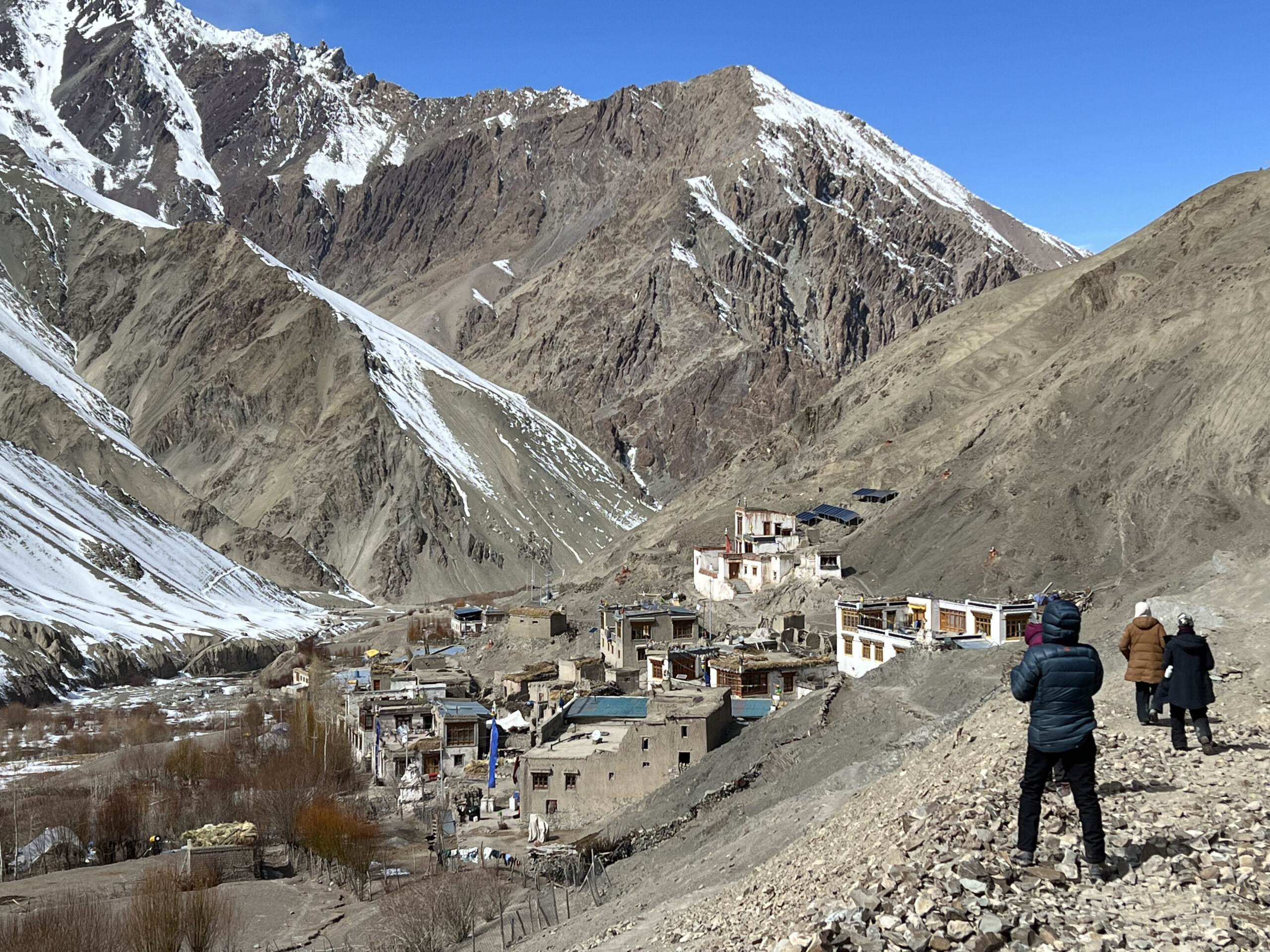
View of Rumbak village, home of the Himalayan Homestay program, Hemis National Park
Photo by Christie Evangelisto
Our trek concluded with a homestay in the picturesque village of Ulley, northeast of Hemis, known for an increasing snow leopard population. The homestay programs are a means for local community members to participate in a collective and benefit from ecotourism. However, often due to limited internet, bookings are made through larger tour groups, leaving the local proprietors with a smaller percentage of profit. We are encouraging more local bookings so the families and the villages can receive a larger share of the profits, which in turn can be turned into local conservation projects.
We hiked up slope behind the village, gaining more incredible views with each step. Though not seeing snow leopards while hiking, we gained an appreciation for the hardship of living in this region, both for people and animals. Our days were filled, one afternoon spent traveling to a village across the ridge looking for wolves said to be in the area, and another day, after receiving word of a snow leopard down valley from Ulley, watching a solitary male. That day, near dusk, we had the joy of hearing a female snow leopard calling for a mate. The sound, though seeming distant, echoed around the hills and was truly mystical to hear.
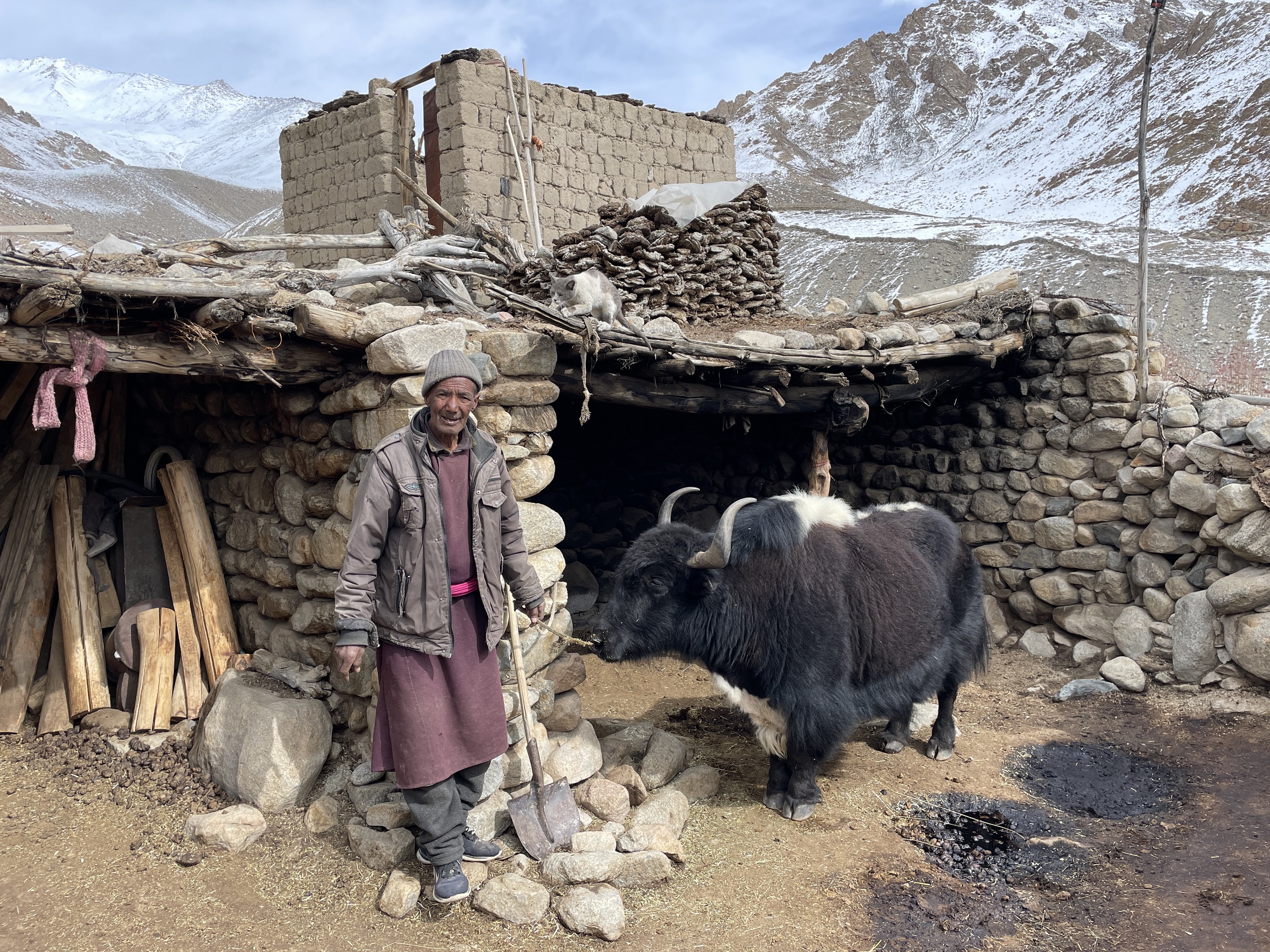
Yak herder living above Ulley village, treating a wound on his yak from a wolf attack while his cat, Billy, “helps”
Photo by Ashleigh Lutz-Nelson
On departure day, our guides delayed our return, instead taking us to a distant village in the opposite direction. We gazed across a river ravine and were rewarded with an extraordinary sight – a male and female snow leopard, side by side. We were privileged to witness a mating pair, a rare and emotionally stirring experience. It symbolized hope for the snow leopards, a species facing the hardships of a challenging environment and increasing human impact. As we departed, we held onto the belief that their offspring would soon be romping on the ridgeline, continuing the circle of life. Witnessing the dedication of the Ladakhi people to preserve these magnificent creatures filled us with faith in their survival.
